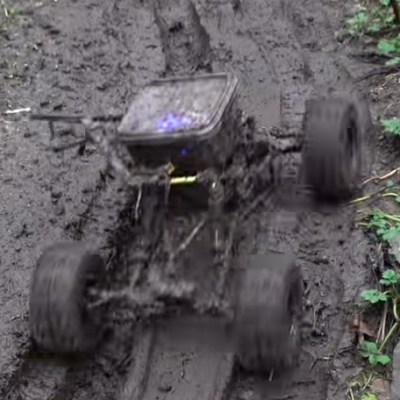It’s fascinating to see what happens when a creative hacker is given a set of constraints to work within. [rctestflight] found themselves in a very specific set of circumstances: Free RC cars from sponsors, and no real purpose for them. Instead of just taking them apart to see what made them tick (itself the past time of many a beginning hacker), [rctestflight] decided to let the RC cars disassemble themselves, destructively, on their way to 100,000 (scale) RC Car Miles, tallying up the distance (and the carnage) in the end as you see in the video below the break.

Re-using a jig and test track (his backyard) from another test, [rctestflight] set up solar powered tether that could power any of the vehicles under test. The vehicles were modified as needed to drive along the circular track on a tether, and once stability was achieved, the cars were set on their own to either drive 100,000 scale miles or die trying.
Seeing as how [rctestflight] hales from the Pacific NorthWet of the United States near Seattle, the endurance test turned out to be not just a test of distance. Among the factors evaluated were how well each vehicle could withstand the mud, grime, and yes, even earthworms, that awaited them.
After each vehicle failed beyond the point of a quick fix, they were all torn down. Where each manufacturer cut corners could clearly be seen, and the weaknesses and strengths of each vehicle were pretty interesting. Plus, there’s a pretty great (awful) uh… rendition… of an iconic 80’s song. Twice. And of course the final conclusion: Exactly how many miles did each vehicle go before catastrophic failure? Check the video for results.
Regular readers will know that [rctestflight] is somewhat of a Hackaday regular, with plentiful great hacks such as this drone boat that sails the high seas of Lake Washington.
















Hello there, just wondering if you have tested the aarma typhon 3s to the typhon 6s. Do you have any spare typhon 3s parts? I need a new wing. Mine snapped at the park when I was driving it. Can’t find I’ve anywhere to easily around here where I am. Or do you think a metal or 3d printed wing would work better? Like a carbon fiber one.
Really interesting… Viewed the video with the perspective of a model hobbiest that also has 2 ATV’s, 1 UTV, a tractor, snow mobile, and lots of other mechanized ICE devices, that require constant care and fixing! These RC models driving through mud is like fine grain sandpaper in their works. And there was no mid-test oil/grease. Drive a Can Am 1000 Outlander ATV (or any other make) through mud and water, and at 2000 miles I’m also changing large wheel bearings (with a 20T press), CV shafts (click, click, click), constantly greasing things, there are 4 regular oil changes (2 diff’s, gearbox, engine), brake pads, bushings, CV belts, ad nauseum. Comparing the test models with ATV’s would be more fair, and in scale miles, the RC models did MUCH BETTER than a full size production ATV. Not as much fun though.
Would drive the neighbours nuts!
Probable would’ve been better (maybe not as much fun), to build a kind of hamster wheel they could just drive strait, without all the other stresses and influences. Just have a revolution counter, and a bit of math. Too many variables in this to be taken seriously.
that wouldnt test suspension and steering robustness. What do you mean by too many variables? Real life is full of variables :)
Perfect point. Too many variables to be taken seriously!
The test was to experiment on a set of RC cars to destruction. The test sample was not representative of the population of all RC cars. He did not claim all RC cars are terrible. Just that for that set of RC cars in his sample, a few were better or worse than others.
The method of research he used was a systematic observation. Systematic observation is a careful observation of specific variables in a setting that uses real-world events. It is a used method in studies focusing on correlational and cannot causal inferences. Only true experimental methods can make causal inferences.
Is the test biased? Yes, it has many confounding variables that affect external and internal validity. But all studies have potential threats to validity. The test is not completely unscientific, contrary to the fact it is more scientific than most studies. An example of this is the Stanford prison study which heavily influenced participant actions and poor recruitment processes
There might be a lot of variables here and the whole test might be a bit goofy but somehow this has improved my impression of electric vehicles.